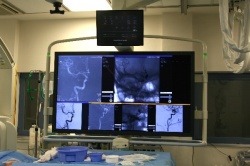The multi-window monitor for interventional imaging
Necessity is the mother of invention, an old saying but particularly true in interventional radiology. Whenever minimally invasive procedures need monitoring from different angles and by different modalities, physicians and technicians in angio labs muster all their DIY skills and build huge monitor towers often with eight screens. Now, however, the new Large Display jointly developed by Siemens and Eizo opens several windows on one screen -- and the physician can even rearrange windows during an intervention


Features include 142 cm (56”) active full-colour medical-grade monitor; 8 megapixel resolution at 4 x HD (3840 x 2160 pixel); fully integrated tableside control; over 200 layout options; connect over 20 image sources.
Professor László Solymosi, head of neuroradiology at University Hospital Würzburg, Germany, has been testing the Large Display there for two years. His department, part of a head clinic established in 1974, was the country’s first of a kind and among the earliest centres of interdisciplinary medical cooperation. The trio of neurology, neuroradiology and neurosurgery is complemented by an ENT clinic and eye clinic. His clinic, explains Prof. Solymosi, has become one without borders, by allowing the physicians to offer the complete range of diagnostics and therapies for neurological diseases, including surgical interventions that need team performance, e.g. skull base surgery.
For neuroradiologists and neurosurgeons interdisciplinary cooperation opens up increasing possibilities for the joint treatment of patients, particularly since major diagnostic imaging examinations, e.g. angiography, have become interventional procedures. Today in Würzburg a radiologist treats 75% of all cerebral aneurysms and the strategy is planned in advance in an interdisciplinary consultation.
In angiography exams, neuroradiologists are supported by monitors functioning as a surgical microscope. Resolution, brightness and contrast play crucial roles, since they ensure even minute vasculature is displayed in diagnostic image quality.
The new Large Display offers brilliant images in full HD-TV quality on a single 56” screen. According to the professor, its major advantage is outstanding flexibility: ‘You can view images not only in the same way as with a wall of monitors, but also adjust window size and layout to your individual requirements and preferences. So, I can enlarge the one image I am particularly interested in during a certain phase of the intervention while maintaining the other, smaller ones, such as the optical path, X-ray image or reference images.’ A keypad offers access to 12 different window layouts that can be reprogrammed any time, even during an intervention.
Professor Solymosi’s clinical experience contributed significantly to the development of the Large Display’s multi-window functionality. He suggested equipping the system with a window displaying physiological parameters, such as pulse oximetry, and with access to 3-D angiographies, which are usually not processed in the angiography suite but on a separate workstation. All imaging modalities integrated into the PACS can easily be called up on the monitor.
‘Enhanced visualisation and flexibility of the Large Display allow us to optimise both workflow and precision of the intervention’, he points out. ‘This multi-window monitor technology has the potential to affect the work of an interventional radiologist positively, thus I am sure it will soon be a standard feature of any angio lab.’
29.12.2010











